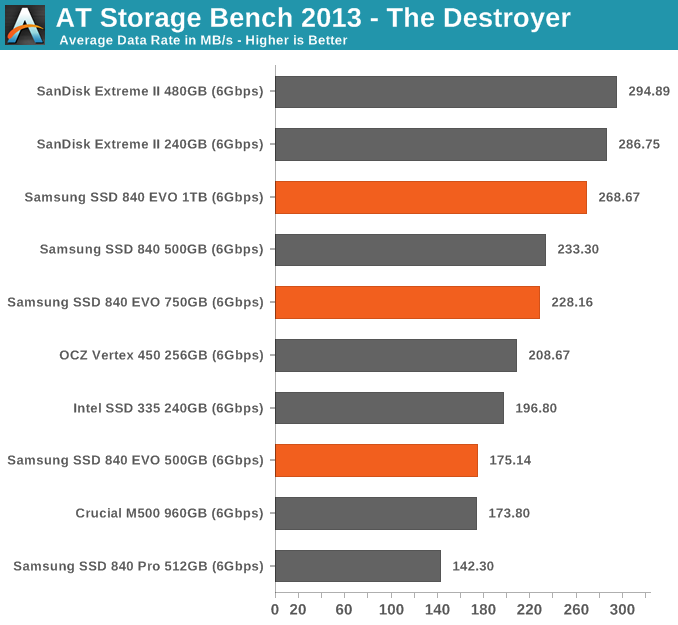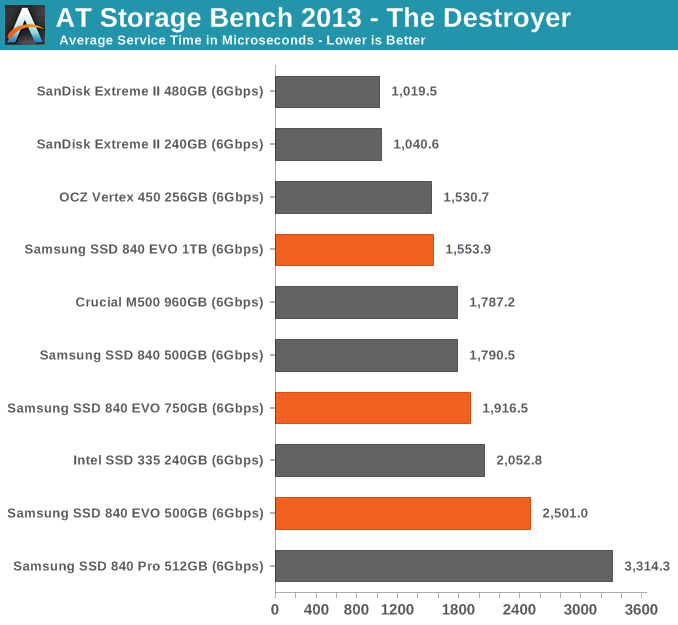Samsung SSD 840 EVO Review: 120GB, 250GB, 500GB, 750GB & 1TB Models Tested
by Anand Lal Shimpi on July 25, 2013 1:53 PM EST- Posted in
- Storage
- SSDs
- Samsung
- TLC
- Samsung SSD 840
AnandTech Storage Bench 2013
When I built the AnandTech Heavy and Light Storage Bench suites in 2011 I did so because we didn't have any good tools at the time that would begin to stress a drive's garbage collection routines. Once all blocks have a sufficient number of used pages, all further writes will inevitably trigger some sort of garbage collection/block recycling algorithm. Our Heavy 2011 test in particular was designed to do just this. By hitting the test SSD with a large enough and write intensive enough workload, we could ensure that some amount of GC would happen.
There were a couple of issues with our 2011 tests that I've been wanting to rectify however. First off, all of our 2011 tests were built using Windows 7 x64 pre-SP1, which meant there were potentially some 4K alignment issues that wouldn't exist had we built the trace on a system with SP1. This didn't really impact most SSDs but it proved to be a problem with some hard drives. Secondly, and more recently, I've shifted focus from simply triggering GC routines to really looking at worst case scenario performance after prolonged random IO. For years I'd felt the negative impacts of inconsistent IO performance with all SSDs, but until the S3700 showed up I didn't think to actually measure and visualize IO consistency. The problem with our IO consistency tests are they are very focused on 4KB random writes at high queue depths and full LBA spans, not exactly a real world client usage model. The aspects of SSD architecture that those tests stress however are very important, and none of our existing tests were doing a good job of quantifying that.
I needed an updated heavy test, one that dealt with an even larger set of data and one that somehow incorporated IO consistency into its metrics. I think I have that test. I've just been calling it The Destroyer (although AnandTech Storage Bench 2013 is likely a better fit for PR reasons).
Everything about this new test is bigger and better. The test platform moves to Windows 8 Pro x64. The workload is far more realistic. Just as before, this is an application trace based test - I record all IO requests made to a test system, then play them back on the drive I'm measuring and run statistical analysis on the drive's responses.
Imitating most modern benchmarks I crafted the Destroyer out of a series of scenarios. For this benchmark I focused heavily on Photo editing, Gaming, Virtualization, General Productivity, Video Playback and Application Development. Rough descriptions of the various scenarios are in the table below:
| AnandTech Storage Bench 2013 Preview - The Destroyer | ||||||||||||
| Workload | Description | Applications Used | ||||||||||
| Photo Sync/Editing | Import images, edit, export | Adobe Photoshop CS6, Adobe Lightroom 4, Dropbox | ||||||||||
| Gaming | Download/install games, play games | Steam, Deus Ex, Skyrim, Starcraft 2, BioShock Infinite | ||||||||||
| Virtualization | Run/manage VM, use general apps inside VM | VirtualBox | ||||||||||
| General Productivity | Browse the web, manage local email, copy files, encrypt/decrypt files, backup system, download content, virus/malware scan | Chrome, IE10, Outlook, Windows 8, AxCrypt, uTorrent, AdAware | ||||||||||
| Video Playback | Copy and watch movies | Windows 8 | ||||||||||
| Application Development | Compile projects, check out code, download code samples | Visual Studio 2012 | ||||||||||
While some tasks remained independent, many were stitched together (e.g. system backups would take place while other scenarios were taking place). The overall stats give some justification to what I've been calling this test internally:
| AnandTech Storage Bench 2013 Preview - The Destroyer, Specs | |||||||||||||
| The Destroyer (2013) | Heavy 2011 | ||||||||||||
| Reads | 38.83 million | 2.17 million | |||||||||||
| Writes | 10.98 million | 1.78 million | |||||||||||
| Total IO Operations | 49.8 million | 3.99 million | |||||||||||
| Total GB Read | 1583.02 GB | 48.63 GB | |||||||||||
| Total GB Written | 875.62 GB | 106.32 GB | |||||||||||
| Average Queue Depth | ~5.5 | ~4.6 | |||||||||||
| Focus | Worst case multitasking, IO consistency | Peak IO, basic GC routines | |||||||||||
SSDs have grown in their performance abilities over the years, so I wanted a new test that could really push high queue depths at times. The average queue depth is still realistic for a client workload, but the Destroyer has some very demanding peaks. When I first introduced the Heavy 2011 test, some drives would take multiple hours to complete it - today most high performance SSDs can finish the test in under 90 minutes. The Destroyer? So far the fastest I've seen it go is 10 hours. Most high performance I've tested seem to need around 12 - 13 hours per run, with mainstream drives taking closer to 24 hours. The read/write balance is also a lot more realistic than in the Heavy 2011 test. Back in 2011 I just needed something that had a ton of writes so I could start separating the good from the bad. Now that the drives have matured, I felt a test that was a bit more balanced would be a better idea.
Despite the balance recalibration, there's just a ton of data moving around in this test. Ultimately the sheer volume of data here and the fact that there's a good amount of random IO courtesy of all of the multitasking (e.g. background VM work, background photo exports/syncs, etc...) makes the Destroyer do a far better job of giving credit for performance consistency than the old Heavy 2011 test. Both tests are valid, they just stress/showcase different things. As the days of begging for better random IO performance and basic GC intelligence are over, I wanted a test that would give me a bit more of what I'm interested in these days. As I mentioned in the S3700 review - having good worst case IO performance and consistency matters just as much to client users as it does to enterprise users.
I'm reporting two primary metrics with the Destroyer: average data rate in MB/s and average service time in microseconds. The former gives you an idea of the throughput of the drive during the time that it was running the Destroyer workload. This can be a very good indication of overall performance. What average data rate doesn't do a good job of is taking into account response time of very bursty (read: high queue depth) IO. By reporting average service time we heavily weigh latency for queued IOs. You'll note that this is a metric I've been reporting in our enterprise benchmarks for a while now. With the client tests maturing, the time was right for a little convergence.

There's simply no comparison between the EVO and Crucial's M500. Even at half the capacity, the EVO does a better job in our consistency test. SanDisk's Extreme II remains the king here but that's more of a performance tuned part vs. something that offers better cost per GB. Note just how impactful the added spare is on giving the EVO an advantage over even the 840 Pro. It's so very important that 840 Pro owners keep as much free space on the drive as possible to keep performance high and consistent.











137 Comments
View All Comments
Timur Born - Sunday, July 28, 2013 - link
Just did a quick test: On my 8 gb RAM system Windows 8 uses quite exactly 1 gb for write caching and all available RAM for read caching. It doesn't matter whether the 1 gb consist of one or several files and whether they fit into the cache as a whole or not (first 1 gb is cached if not).1Angelreloaded - Friday, July 26, 2013 - link
Hold on a second correct me if I'm wrong on this paradox. Did Samsung not scale back on NAND production in order to drive the price up for greater bloated profits, now as stated in Korea press conference they want "SSDs for everyone". WTF is going on here, and why are SSDs not at more reasonable pricing by now about .33cents per gig.?They had a complete shot at burying HDDs after the flood and the price hike.FunBunny2 - Friday, July 26, 2013 - link
Don't confuse capitalists with intelligence. They look at unit margin and ignore gross profit. IOW, they'd rather sell 100 at $2 margin than 1,000 at $1 margin. They're stupid.MrSpadge - Saturday, July 27, 2013 - link
There's also the factor of marget saturation to take into account. You can't sell an infinite number of drives.Notmyusualid - Friday, July 26, 2013 - link
Exciting technology indeed! Impressive numbers, nice identification of spare computer resources, and put to good use too. I'd imagine this would be the go-to drive for most users...But I'd like my clocks available for my applications thanks.
In addition, I'm not willing to put my data on any non-enterprise disk now, cost be damned. Burned too many times now.
Interesting product though....
z28dreams - Friday, July 26, 2013 - link
I recently saw the Plextor M5P (pro) for $190 on sale.If the 840 evo comes out in the same price range, which would be a better buy?
It looks like the write seems of the M5P are better, but I'm not about overall performance.
K_Space - Friday, July 26, 2013 - link
Help a noob here: How is Rapid any different to a custom nonvolatile RAM disk with your selected cached files stored on it & these being written to the SSD at an interval? Is it mainly because Rapid can writes in blocks and it's more intelligent in its choice of cached files?wpapolis - Saturday, July 27, 2013 - link
Hey there all,I have a MacBook 13" from late 2008, the first gen of the unibody construction (Model MB467*/A).
My bus speed is SATA 3Gbit/s.
What's the best SSD for me?
Trim doesn't work automatically for me, though I have found the commands to use in terminal to enable it.
This Samsung drives looks really good, but it seems like I won't be able to use RAPID, or perhaps even TRIM. Plus I am limited by my bus speed. Should I still go for this Samsung just because the price might be the same as lower featured alternatives?
What do you guys suggest? I want one in the 250GB range.
Thanks,
Bill
TheinsanegamerN - Saturday, July 27, 2013 - link
if you have a mac, the samsung is your best bet. TRIM can be enabled quite easily on a mac if it is not done automatically, so you can use trim. as for RAPID, it replaces window's terrible i/o caching process. osx does not have this problem, so you dont have to worry about that. now, the sata2 interface will be a bottleneck, but it will still be much faster than a hard drive. id go for either this evo drive or the 840 250gbwpapolis - Saturday, July 27, 2013 - link
Yes, you reaffirmed what I was already thinking.Plus, when I upgrade this MacBook, I have the option to move the drive. Though, I have to say, performance is still pretty good, but each OS upgrade seems to make things a bit more sluggish.
With 8GB RAM, and a current SSD, things should be good for a bit longer.
Thanks for the feedback,
Bill